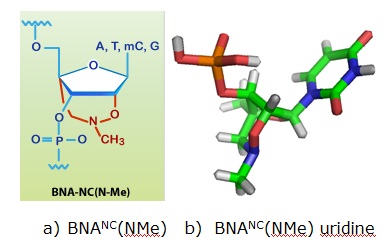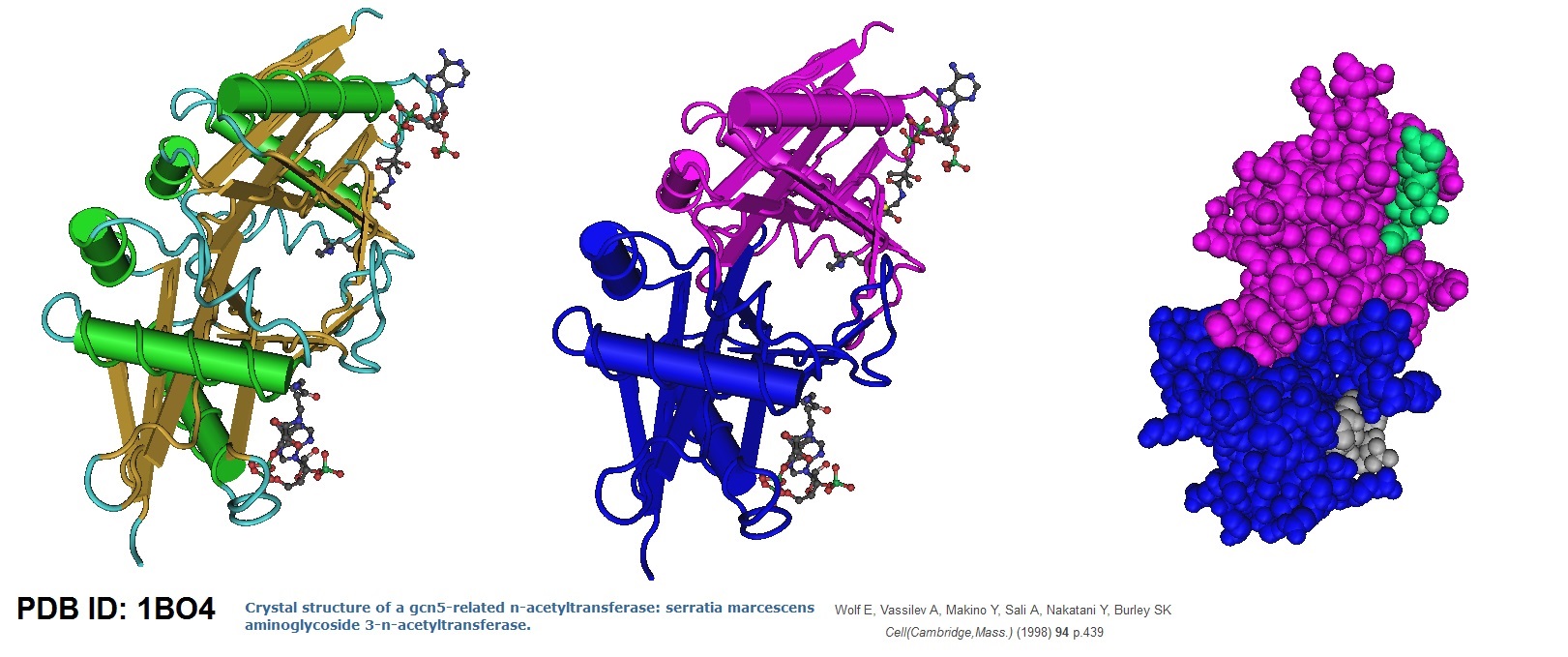A new BNA-NC-DNA-peptide conjugate as a potential treatment for multi-drug resistant infections.
A new type of BNA/DNA-peptide conjugate has been developed for the treatment of drug-resistant infections. This new BNA/DNA-peptide conjugate is thought to become a useful antimicrobial and chemotherapeutic agent.
Lopez et al. (2015) recently published a paper where a new type of BNANC-DNA-peptide conjugate was investigated for its use as an antisense agent for the treatment of amikacin resistant infections. The research group tested a BNANC-DNA hybrid co-oligomer conjugated to a cell permeable peptide mimic named CPPBD4 for its ability to reduce the level of resistance in A. baumannii A 155 cells.
“Christina Lopez, Brock A. Arivett, Luis A. Actis, Marcelo E. Tolmasky; Inhibition of AAC(6')-Ib-Mediated Resistance to Amikacin in Acinetobacter baumannii by an Antisense Peptide-Conjugated 2’,4’-Bridged Nucleic Acid-NC-DNA Hybrid Oligomer. Antimicrobial Agents and Chemotherapy. September 2015 Volume 59 Number 9. http://aac.asm.org/content/early/2015/07/07/AAC.01304-15.abstract”
The conjugation of compounds such as oligonucleotides or oligonucleotide mimetics to cell-penetrating peptides is a now a well known strategy to guide antisense oligomers inside cells. These peptides contain a small number of amino acids, usually less than 30, are amphipathic, and have a net positive charge. Using this strategy, Lopez at al. used BNAs for the design of an antisense inhibitor peptide-conjugate to decrease the resistance to amikacin as mediated by AAC(6’)-Ib, a wide-spread aminoglycoside-modifying enzyme.
The use of CPPBD4 in combination with amikacin for the treatment of infected larvae of the greater wax moth Galleria mellonella lowered the level of resistance to amikacin. The result was that the larvae showed a significant increase in survival rates. The reported observed survival rates were similar to the survival rates of non-infected larvae. Reported results indicated that the hybrid analogs composed of BNANC and DNA conjugated to a cell-permeable peptide reached the cytosol of A. baumannii where it exhibited an antisense effect. The peptide-BNANC-conjugate investigated is reported to be useful for the treatment of amikacin resistant bacterial infections.
The antisense peptide-BNA-oligonucleotide conjugate targets the aminoglycoside 6’-N-acetyltransferase type Ib [AAC(6’)-Ib] gene from A. baumannii by binding to nucleotide sequences around the initiation codon of this gene. The chemical structure and a model of a BNANC(NMe) residue is shown in figure 1.

Figure 1: Chemical structure and model of a 2’,4’-BNANC residue.
2’,4’-Bridged nucleic acid-NC (BNANC) analogs exhibit beneficial features such as higher binding affinity to a cRNA, excellent single-mismatch discriminating ability, and tests carried out in mice showed that BNANC-based antisense molecules have minimal toxicity. The 2’,4’-BNANC antisense oligonucleotide peptide-conjugate CPPBD4 inhibits the growth of A. Baumani A155 thereby inhibiting bacterial infection. Lopez et al investigated the 2’,4’-BNANC antisense oligonucleotide conjugate CPPBD4 for its use of inhibiting the expression of resistance to amikacin (AMK) in A. Baumani A155.
CPPBD4
The peptide BNA-conjugate used for the study
(RXR)4XB-Cys-SMCC-C6 amino-2’,4’-BNANC-DNA
(RXR)4XB-Cys-SMCC-C6 amino-C+TGCT+GCGT+AACA+TC
+ indicates the location of the BNA monomers; R = arginine; X = 6-aminohexanoic acid; B = β-alanine; SMCC = succinimidyl 4-[N-maleimidomethyl]cyclohexane-1-carboxylate.
Targets the nucleotide sequence depicted in figure 2.

Figure 2: Nucleotide sequences targeted by the antisense BNANC-DNA peptide conjugate. The nucleotide sequences around the initiation codon of the A. baumanii (Ab) A155 aac(6’)-IB gene are shown at the bottom (Lopez at al. 2015). The nucleotide sequence with the location of the BNA monomers (in magenta) are shown at the top.
Acinetobacter baumannii
Acinetobacter baumannii is a short, rod-shaped Gram-negative bacterium that can be an opportunistic pathogen in humans. People with compromised immune systems are often affected by it. A. baumannii is increasingly becoming important in hospital-derived infections. The bacteria can also be found in the environment, for example in various soils and in water.
The A. baumannii A155 strain was isolated from a urinary sample. This strain harbors the aac(6’)-Ib gene which is the most common amikacin (AMK) resistance
gene found in Gram-negative pathogens.
Hospital-acquired infections (HAI) or nosocomial infections are infection acquired during the stay in a hospital or an infection developed by hospital staff. The World Health Organization defines them as follows
“Infections acquired in a hospital by a patient who was admitted for a reason other than infection. An infection occurring in a patient in a hospital, or other health care facility, in whom the infection was not present, or incubating at the time of admission. This includes infections acquired in the hospital but appearing after discharge, and also occupational infections among staff of the facility.”
Amikacin
Amikacin is an aminoglycoside antibiotic used for the treatment of different bacterial infections. Amikacin is often used for the treatment of severe, hospital-acquired infections caused by multidrug-resistant Gram-negative bacteria. Usually, amikacin is used as a last-resort medication against multidrug-resistant bacteria.
(Source:http://www.toku-e.com/Assets/MIC/Amikacin%20hydrate.pdf).
Amikacin is an aminoglycoside antibiotic derived from kanamycin A that similar to other aminoglycosides disrupts bacterial protein synthesis by binding to the 30S ribosome of susceptible organisms. Binding interferes with mRNA binding and tRNA acceptor sites leading to the production of non-functional or toxic peptides. Other mechanisms not fully understood may confer the bactericidal effects of amikacin. Amikacin is also nephrotoxic and ototoxic.
Figure 3: Structures and Models of Amikacin (Source: Drugbank http://www.drugbank.ca/drugs/DB00479).
Aminoglycosides
Aminoglycosides are very effective tools to fight infections but unfortunately resistance levels are growing. Over the years bacteria have developed numerous mechanisms to resist the actions of aminoglycosides. Bacteria can use enzymatic modifications to defeat the actions of antibiotics. The aminoglycoside 6’-N-acetyltransferase type Ib [AAC(6’)-Ib] is of great clinical relevance and is found in over 70% of AAC(6)-I-producing gram-negative clinical isolates therefore it has been the subject of numerous studies. The resistance is due to synthesis of the aminoglycoside 6'-N-acetyltransferase type I [AAC(6')-I] enzyme which modifies amikacin and tobramycin. AAC(6′)-Ib (aminoglycoside 6′-N-acetyltransferase type Ib) is found in a wide variety of gram-negative pathogens. The enzyme has significant microheterogeneity at its N-termini and the aac(6′)-Ib gene is often present in integrons, transposons, plasmids, genomic islands, and other genetic structures.
Since the study of bacterial infections requires animal models and mammalian models of infections are costly, insect infection models have been shown to provide valuable alternatives. Larvae of the greater wax moth Galleria mellonella have been shown to provide valuable insight into pathogenesis of many microbial infections. Results obtained with Galleria larvae infected by direct injection through the cuticle are reported to consistently correlate with those of similar mammalian studies and are therefore now used as a powerful infection model system.
Reference
Weblinks
http://www.uphs.upenn.edu/bugdrug/antibiotic_manual/aminoglycosideresistance.htm
http://emedicine.medscape.com/article/236891-overview
http://www.cdc.gov/HAI/organisms/acinetobacter.html
Christina Lopez, Brock A. Arivett, Luis A. Actis, Marcelo E. Tolmasky; Inhibition of AAC(6=)-Ib-Mediated Resistance to Amikacin in Acinetobacter baumannii by an Antisense Peptide-Conjugated 2’,4’-Bridged Nucleic Acid-NC-DNA Hybrid Oligomer. Antimicrobial Agents and Chemotherapy. September 2015 Volume 59 Number 9.
Rahman SM, Seki S, Utsuki K, Obika S, Miyashita K, Imanishi T.; 2007. 2',4'-BNA(NC): a novel bridged nucleic acid analogue with excellent hybridizing and nuclease resistance profiles. Nucleosides Nucleotides. Nucleic Acids 26:1625–1628. http://dx.doi.org/10.1080/15257770701548980.
Ramarao N, Nielsen-Leroux C, Lereclus D.; The insect Galleria mellonella as a powerful infection model to investigate bacterial pathogenesis. J Vis Exp. 2012 Dec 11;(70):e4392. doi: 10.3791/4392.
María S. Ramirez, Nikolas Nikolaidis and Marcelo E. Tolmasky; Rise and dissemination of aminoglycoside resistance: the aac(6′)-Ib paradigm. Front. Microbiol., 17 May 2013 | http://dx.doi.org/10.3389/fmicb.2013.00121. http://www.ncbi.nlm.nih.gov/pmc/articles/PMC3656343/pdf/fmicb-04-00121.pdf
Matthew W. Vetting, Luiz Pedro S. de Carvalho, Michael Yu, Subray S. Hegde, Sophie Magnet, Steven L. Roderick, John S. Blanchard; Minireview: Structure and functions of the GNAT superfamily of acetyltransferases. Archives of Biochemistry and Biophysics 433 (2005) 212–226.
Yamamoto T, Harada-Shiba M, Nakatani M, Wada S, Yasuhara H, Narukawa K, Sasaki K, Shibata MA, Torigoe H, Yamaoka T, Imanishi, T, Obika S. 2012. Cholesterol-lowering action of BNA-based antisense oligonucleotides targeting PCSK9 in atherogenic diet-induced hypercholesterolemic mice. Mol Ther Nucleic Acids 1:e22. http://dx.doi.org/10.1038/mtna.2012.16.
WHO/CDS/CSR/EPH/2002.12: Prevention of hospital-aquired infections. A practical guide 2nd edition. (Source: http://www.who.int/emc).
Appendix
GCN5-related N-acetyltransferase
Over more than 150 distinct enzymes found in the kingdom of life appear to have evolved from a common ancestral N-acetyltransferase (NAT). Wolf et al. in 1998 reported the structure for the canonical GCN5-related N-acetytransferase. This enzyme belongs to the GCN5-related NATs or GNAT super family. The GCN5-related N-acetytransferases are enzymes that are universally distributed in nature. The enzymes use acyl-CoAs for the acylation of their substrates. The structure of the GCN5-related N-acetyltransferase is shown in the figure below. One subgroup of these enzymes, a eubacterial aminobglycoside N-acetyltransferase, catalyzes the acetyl group addition to aminoglycoside antibiotics directed against aerobic, gram-negative bacilli. Serratia marcescens are rod-shaped gram-negative bacteria, a Enterobacteriaceae, that is a human pathogen involved in hospital-acquired infections. This enzyme has the same N-terminal end as the A. baumannii A 155 aac(6’)-1b gene product.
Aminoglycoside N-acetyltransferases catalyze the regioselective acetylation of one of the four amino groups found on a diverse set of aminoglycosides having antibiotic properties. Acetylation of an amino group reduces the affinity of these compounds for the acceptor tRNA site on the 30S ribosome by four orders of magnitude. This makes bacteria expressing these genes resistant to antibiotics.

Figure 4: Model of the GCN5-related N-acetyltransferase. In 1998 Wolf et al. determined the X-ray structure of a canonical GCN5-related N-acetyltransferase (GNAT), the Serratia marcescens aminoglycoside 3-N-acetyltransferase, bound to coenzyme A (CoA) at a 2.3 Å resolution. This enzyme belongs to the GNAT superfamily of proteins.
Reference
Eva Wolf, Alex Vassilev, Yasutaka Makino, Andrej Sali, Yoshihiro Nakatani, Stephen K. Burley; Crystal Structure of a GCN5-Related N-acetyltransferase. Serratia marcescens Aminoglycoside 3-N-acetyltransferase. p439–449, 21 August 1998. DOI: .
-.-